
‘Superintendents daily returns and receipt book - Evelyn’ [1]
Within Special Collections we have a variety of items, each with its own story to tell. One such item is the ‘Superintendents daily returns and receipt book – Evelyn’, This book is full of interesting particulars that really give you a unique sense of the times. The book dates from the 25 July 1934 to the 29 August 1936 and the ‘Evelyn’ of the title refers to the Evelyn Street Baths. Each neatly printed page lists the services the public bath offered along with the cost for those services; in adjoining columns the superintendent has assiduously filled out the payments collected for the goods and services each day. I found myself going back and forth researching different elements of the book to try and gain more insight into the baths and its location, the books original home.

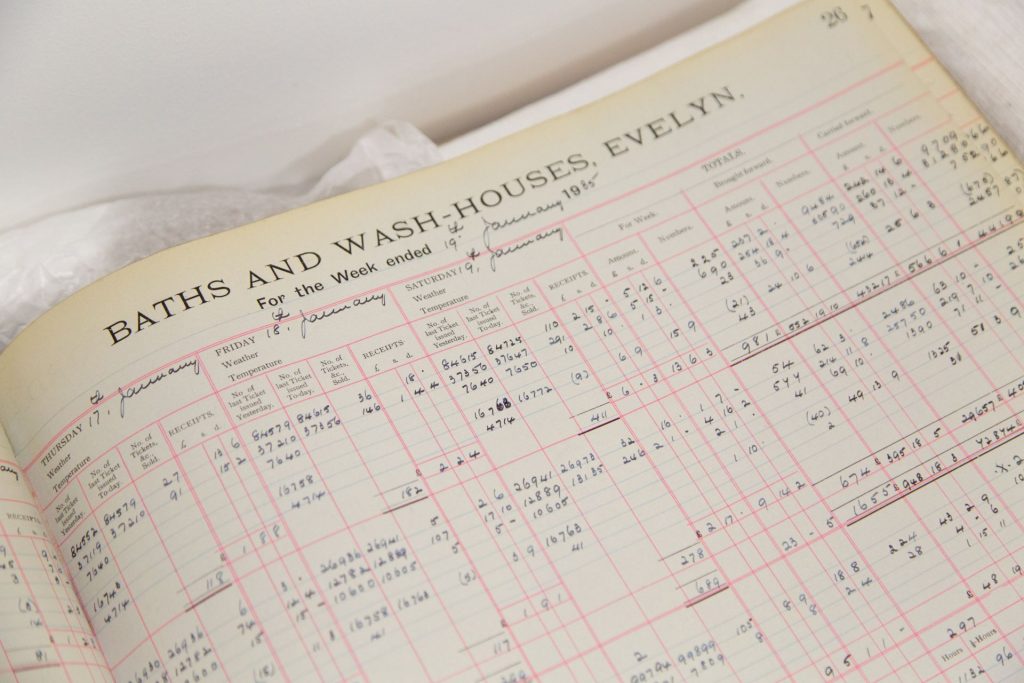
‘Superintendents daily returns and receipt book - Evelyn’ [1]
Armed only with the knowledge that the book had some relationship to Evelyn Street in Deptford, I first began by simply searching for the ‘Evelyn Street Baths’ in maps, public records, image databases and other archival repositories but, with no results. I also contacted different research and library establishments to try and find what information they held on the baths or the companies associated with them.
I emailed the ‘Baths and Wash Houses Historical Archive’ [3], based in Newcastle-under-Lyme, Staffordshire to enquire what exactly a Russian Vapour was, which was one of the services offered at the bath. They were incredibly helpful, providing images and reference books to check, such as the incredibly informative ‘Anges Campbell’s Report Public Baths and Wash-Houses in the United Kingdom 1918’ [5]. Through the insightful correspondence with the ‘Baths and Wash Houses Historical Archive’ [3], who explained about the different vapour treatments and hot boxes so thoroughly in their response, I was able to understand what a Russian vapour bath was.
From what I understand a Russian Vapour was most likely a treatment that involved a steam bath or a steam box, sometimes referred to as simply Vapour Baths or the Vapour-Box by Robert Owen Allsop in ‘Public Baths and Wash-Houses’ [6], c.1894. Alfred W. S. Cross ‘Public Baths and Wash-Houses 1906’ [7] refers also to Russian Baths and Russian (Vapour) Baths. I also learnt that a Turkish bath or Turkish Vapour utilised dry heat whereas the Russian equivalent used wet steam.

Sign used to advertise the Russian Vapour Baths in Brick Lane [2]
It is said that the Russian baths were an important part of the culture of the East End Jewish community and that they ‘…were mostly used by men following work on a Friday evening, before going to the synagogue for prayers’ [2]. The baths in Brick Lane were known as ‘Schewzik’s’, named after their owner Benjamin Schewzik. I considered the influential position that John Evelyn had in Deptford as not only is the a street named is not the only thing that has shared his name in the area, Using this knowledge I explored areas away from Evelyn street focusing mainly on buildings which bore the Evelyn name in the area, but to no avail so the search continued.
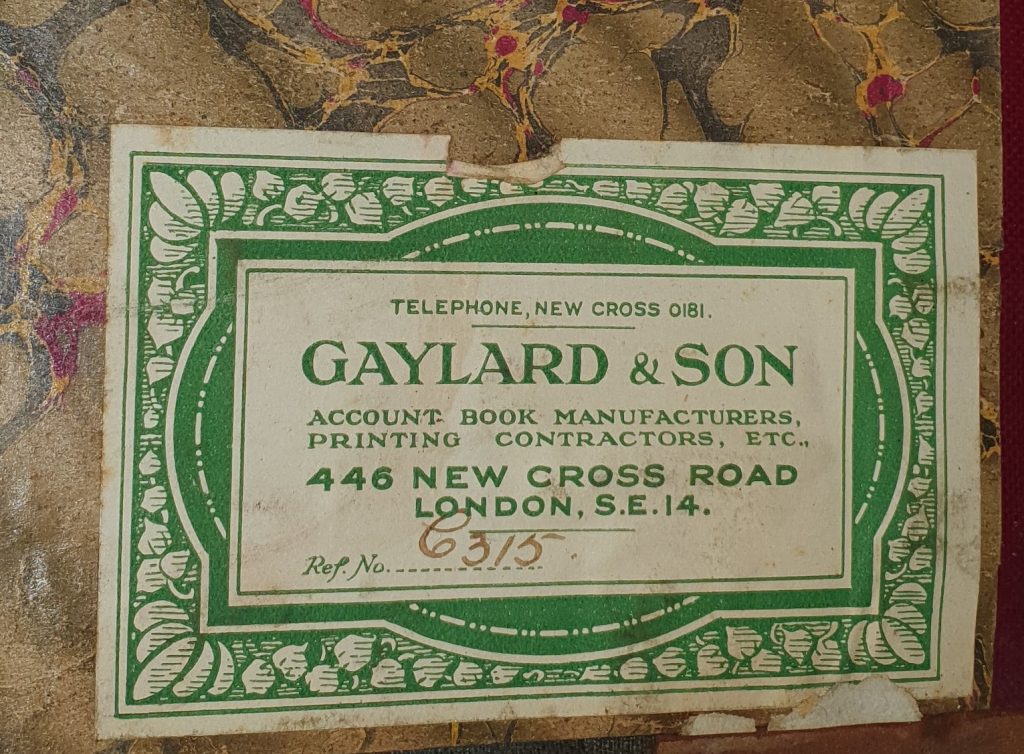
‘Superintendents daily returns and receipt book - Evelyn’ [1]
A small sticker within the inside of the fabulously marbled front cover of the superintendent’s book tells us that the book itself was produced by Gaylard and Son, an accounts book manufacturer and printing contractor company based in New Cross. I explored their history in the hope that they may have saved their records, which could contain information on who purchased their books and where they were delivered to. Sadly, the business went into liquidation in 1994 and I could find no record, receipts or contact details of the company. So, while interesting this didn’t help me in my search for the bath.
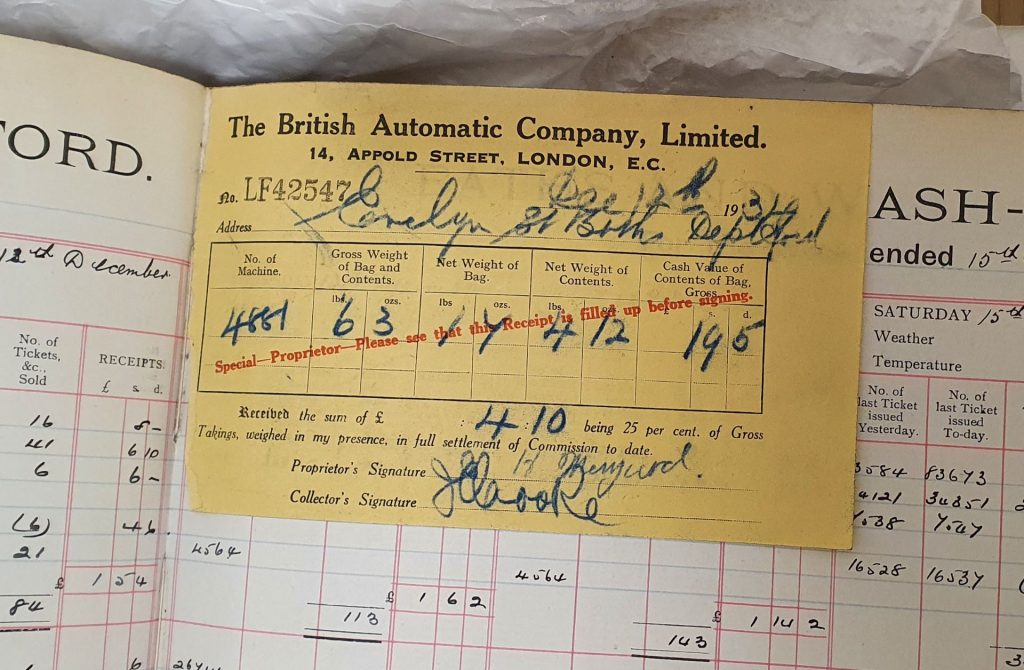
‘Superintendents daily returns and receipt book - Evelyn’ [1]
In some pages there are receipts from the British Automatic Company, who most likely provided, maintained, and collected the money from, a vending machine in the baths. Although a very well-known company who had contracts with railways there is not much readily available information on the business. The National Archive does have material from the British Automatic Company Limited however this only covers the period 1967 to 1970 [17]. The receipts in the superintendent’s book give the address of the baths as Evelyn Street Bath Deptford, but after further investigation I discovered that this was just how the bath was popularly referred to at the time.
In my research a truly fascinating and insightful blog post was shared with me entitled ‘An Urban Sociology of Water’ by Les Back’. The post explores public washing and states that ‘ The social life of water and washing provides a way to understand the history of cities’ [4] There is mention of the Laurie Grove Bath in Deptford and the Clyde Street Baths but, nothing of the Evelyn Street Bath.
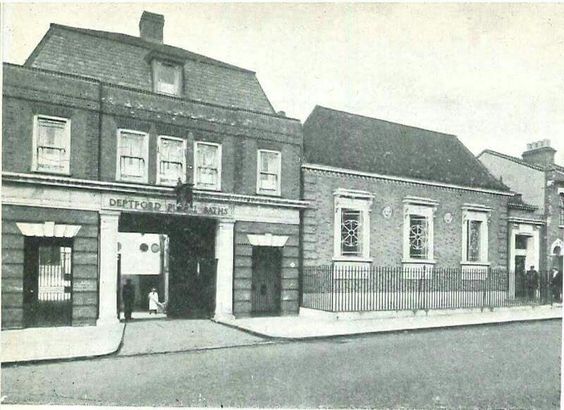 [13]
[13] 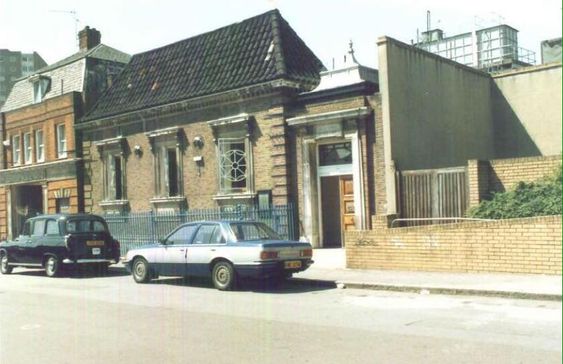 [14]
[14]
The first, black and white, image[13] was the only reference I could find indicating the presence of a bath house in the Deptford area, other than the more well-known Laurie Grove Baths. But being unable to find its location on a map or any source information for the image meant that the search continued. I later came across a second, colour, image [14] which is clearly a later image but from the architecture I could tell it was the same building in the first photograph. In the second image however the building is identified as being the Clyde Street Baths and Library, clearly eliminating it as the Evelyn Street Baths.
After further discussion with colleagues, I decided to search street records of the dates the book covered, which led me to find out that Evelyn Street had been bombed in the 1940s. This helped narrow my search to pre- World War II. I traced the development of Evelyn Street to see how the road had changed over the years and where there was a large enough space for a building that could accommodate a public baths. I assumed a bath house would be larger than a residential building, like the other baths on the map. The first evidence indicating the location of the bathhouse on Evelyn Street came after some extensive exploration of maps between 1900 and 1970. I was unsure if the baths had been destroyed in the bombing in 1940 but through meticulously studying the Evelyn Public Baths daily return book, I was certain that the bath house was in existence and providing service between 1934 and 1936. I focused my search as close to those dates as possible though eventually I extended my search to later years as later maps provided better detail of the area. Finally, I found a bathhouse on the map series OS 1:1,250/1:2,500, 1944–1970, online, on the National Library of Scotland.
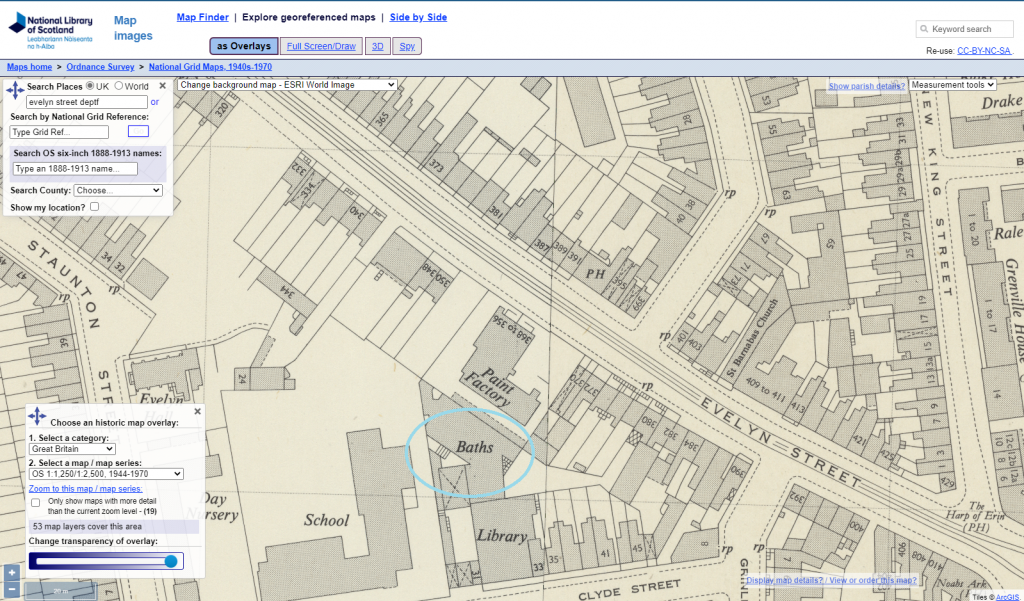
Georeferenced maps — National Library of Scotland (nls.uk)[11]
Everything was coming together! The baths were not in fact directly on Evelyn Street but, were between Evelyn and Clyde Street and were attached to the Clyde Street library, and bore the sign Deptford Public Bath. The baths opened in 1928 and served the community until around 1988. [16]

Report of the Medical Officer of Health for Deptford Borough [15]
With this added information I was even able to find a 1961 ‘Report of the Medical Officer of Health for Deptford Borough’ [15] which refers to the Evelyn Baths as one of three in the area maintained by the council. This report refers to the bath by both its popular name and gives reference to its location.
It is not clear what exactly happened to the original building but, the Lewisham Indochinese Community Centre now stands in the place of both the library and the bath. The construction of the Community Centre was completed in November 1998.[12]
This started out as an investigation into where the ‘Superintendents daily returns and receipt book’ had come from but, it took me on a wonderful journey of research and discovery, giving me the opportunity to think creatively and explore different tools and resources of information many of which I will use in the future.
Acknowledgement
A version of this piece has also been published on the Bath and Wash Houses: Historical Archives webpage under the title ‘ Finding the ‘Evelyn Public Baths’ Deptford Public Baths 1928 – 1988’. [3]
References
- ‘Superintendents daily returns and receipt book – Evelyn’ uncatalogued special collections item
- Jewish Museum London. 2021. Russian Vapour Baths < https://jewishmuseum.org.uk/50-objects/2002-27/> [Accessed 07 February 2022]
- Bath and Wash Houses: Historical Archives [Online] Available at <https://www.bathsandwashhouses.co.uk/> [Accessed 07 February 2022]
- Back, L. An Urban Sociology of Water [Online] CUCR: Centre for Urban and Community Research Available at: <https://cucrblog.wordpress.com/2016/03/12/an-urban-sociology-of-water-by-les-back/> [Accessed 07 February 2022]
- Campbell, A. 1918. Report on Public baths and wash-houses in the United Kingdom. Edinburgh; Constable.
- Allsop, R., 1894. Public Baths and Wash-houses … Illustrated, etc. E. & F.N. Spon: London.
- Cross, A., 1906. Public Baths and Wash Houses. [Place of publication not identified]: B.T. Batsford.
- Gov.uk. 1994. Gaylard & Son Limited Filing History [Online] Available at <https://find-and-update.company-information.service.gov.uk/company/00712703/filing-history> [Accessed 10 February 2022]
- RomanticLondon.org. Undated. Explore Horwood’s Plan – Romantic London. [Online] Available at <http://www.romanticlondon.org/explore-horwoods-plan/#17/51.48654/-0.03529> [Accessed 17 February 2022]
- National Library of Scotland (NLS.UK). c. 1900s. OS1: 1 Million – 1:10K, 1900s [Online] Available at <https://maps.nls.uk/geo/explore/#zoom=17&lat=51.48417&lon=-0.03003&layers=175&b=1 > [Accessed 17 February 2022]
- National Library of Scotland (NLS.UK). 1944 – 1970. OS 1:1, 250/1:2,500, 1944 – 1970 [Online] Available at < https://maps.nls.uk/geo/explore/#zoom=19&lat=51.48217&lon=-0.02860&layers=170&b=1> [Accessed 17 February 2022]
- Lewisham Indochinese Community Centre. 2022. Our history [Online] Available at <https://indochinese.co.uk/about-us/our-history/> [Accessed 17 February 2022]
- n.d. Clyde Street baths and library. [image] Available at: <https://i.pinimg.com/564x/aa/a5/69/aaa5696364263a70553377810cb2405a.jpg> [Accessed 17 February 2022].
- n.d. Evelyn Public Baths Deptford [image] Available at: <https://i.pinimg.com/564x/e4/76/0c/e4760ca3d264cfde0a5deb25239befda.jpg> [Accessed 17 February 2022].
- 1961. Report of the Medical Officer of Health for Deptford Borough [image] Available at:<https://wellcomelibrary.org/moh/report/b18237204/37#?c=0&m=0&s=0&cv=37&z=-0.1377%2C0.4526%2C1.4228%2C0.5554 > [Accessed 17 February 2022].
- 2014. Edith’s Streets: London Local History [Online] Available at < http://edithsstreets.blogspot.com/2014/12/london-and-greenwich-railway-deptford.html >
- the British Automatic Company Limited material at The National Archive (Reference: T 193/350)
by Shanique Thompson, Special Collection and Archives Assistant
Leave a Reply